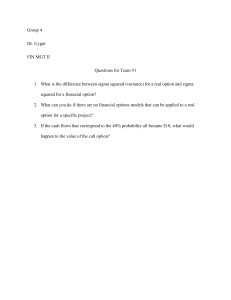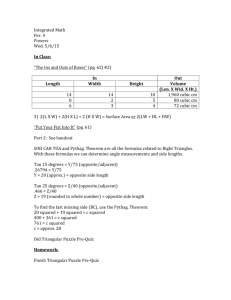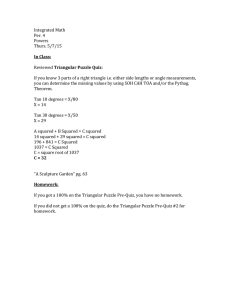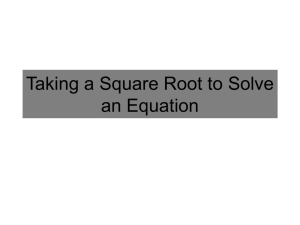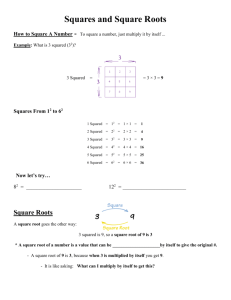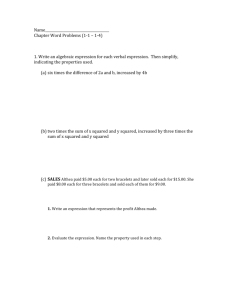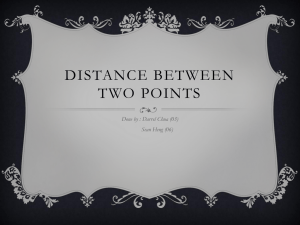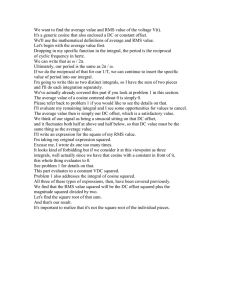Use Theorem 4.14 and its corollary to show that if X11, X12,...,X1n1
advertisement
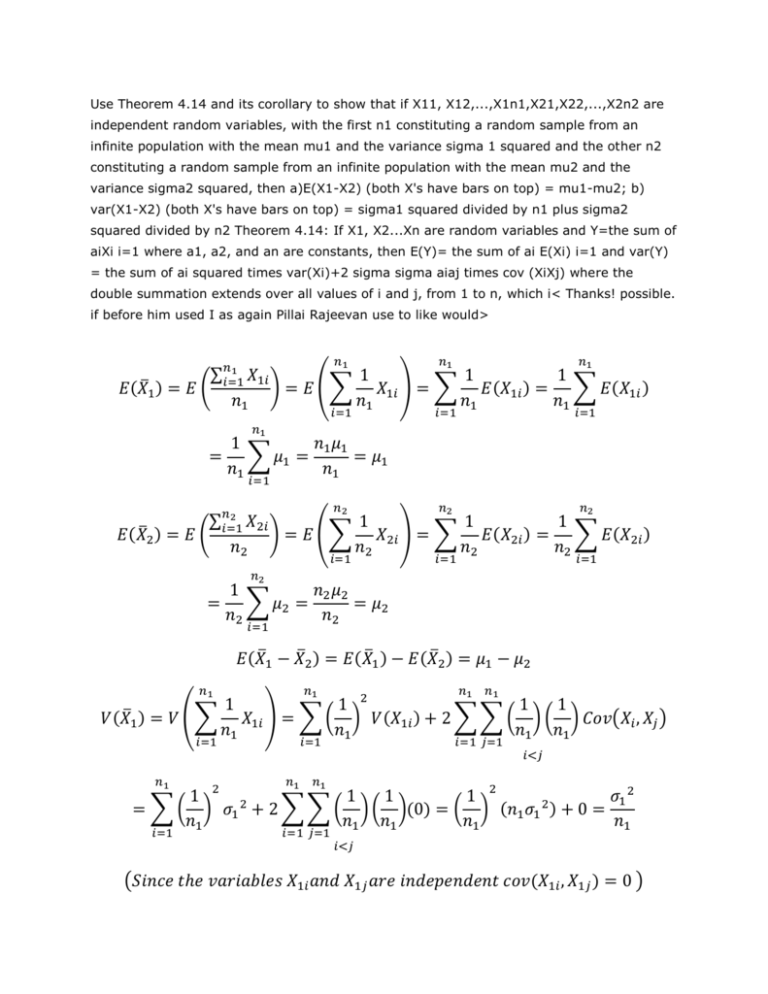
Use Theorem 4.14 and its corollary to show that if X11, X12,...,X1n1,X21,X22,...,X2n2 are independent random variables, with the first n1 constituting a random sample from an infinite population with the mean mu1 and the variance sigma 1 squared and the other n2 constituting a random sample from an infinite population with the mean mu2 and the variance sigma2 squared, then a)E(X1-X2) (both X's have bars on top) = mu1-mu2; b) var(X1-X2) (both X's have bars on top) = sigma1 squared divided by n1 plus sigma2 squared divided by n2 Theorem 4.14: If X1, X2...Xn are random variables and Y=the sum of aiXi i=1 where a1, a2, and an are constants, then E(Y)= the sum of ai E(Xi) i=1 and var(Y) = the sum of ai squared times var(Xi)+2 sigma sigma aiaj times cov (XiXj) where the double summation extends over all values of i and j, from 1 to n, which i< Thanks! possible. if before him used I as again Pillai Rajeevan use to like would> 𝑛1 𝑛1 𝑛1 𝑖=1 𝑖=1 𝑖=1 𝑛2 𝑛2 𝑛2 𝑖=1 𝑖=1 𝑖=1 1 ∑𝑛𝑖=1 𝑋1𝑖 1 1 1 ̅ 𝐸(𝑋1 ) = 𝐸 ( ) = 𝐸 (∑ 𝑋1𝑖 ) = ∑ 𝐸(𝑋1𝑖 ) = ∑ 𝐸(𝑋1𝑖 ) 𝑛1 𝑛1 𝑛1 𝑛1 𝑛1 = 1 𝑛1 𝜇1 = 𝜇1 ∑ 𝜇1 = 𝑛1 𝑛1 𝑖=1 2 ∑𝑛𝑖=1 𝑋2𝑖 1 1 1 𝐸(𝑋̅2 ) = 𝐸 ( ) = 𝐸 (∑ 𝑋2𝑖 ) = ∑ 𝐸(𝑋2𝑖 ) = ∑ 𝐸(𝑋2𝑖 ) 𝑛2 𝑛2 𝑛2 𝑛2 𝑛2 = 1 𝑛2 𝜇2 = 𝜇2 ∑ 𝜇2 = 𝑛2 𝑛2 𝑖=1 𝐸(𝑋̅1 − 𝑋̅2 ) = 𝐸(𝑋̅1 ) − 𝐸(𝑋̅2 ) = 𝜇1 − 𝜇2 𝑛1 𝑛1 𝑛1 𝑛1 𝑖=1 𝑖=1 𝑖=1 𝑗=1 1 1 2 1 1 𝑉(𝑋̅1 ) = 𝑉 (∑ 𝑋1𝑖 ) = ∑ ( ) 𝑉(𝑋1𝑖 ) + 2 ∑ ∑ ( ) ( ) 𝐶𝑜𝑣(𝑋𝑖 , 𝑋𝑗 ) 𝑛1 𝑛1 𝑛1 𝑛1 𝑖<𝑗 𝑛1 𝑛1 𝑛1 𝑖=1 𝑖=1 𝑗=1 1 2 2 1 1 1 2 𝜎1 2 2 = ∑ ( ) 𝜎1 + 2 ∑ ∑ ( ) ( )(0) = ( ) (𝑛1 𝜎1 ) + 0 = 𝑛1 𝑛1 𝑛1 𝑛1 𝑛1 𝑖<𝑗 (𝑆𝑖𝑛𝑐𝑒 𝑡ℎ𝑒 𝑣𝑎𝑟𝑖𝑎𝑏𝑙𝑒𝑠 𝑋1𝑖 𝑎𝑛𝑑 𝑋1𝑗 𝑎𝑟𝑒 𝑖𝑛𝑑𝑒𝑝𝑒𝑛𝑑𝑒𝑛𝑡 𝑐𝑜𝑣(𝑋1𝑖 , 𝑋1𝑗 ) = 0 ) 𝑛2 𝑛2 𝑛2 𝑛2 𝑖=1 𝑖=1 𝑖=1 𝑗=1 1 1 2 1 1 𝑉(𝑋̅2 ) = 𝑉 (∑ 𝑋2𝑖 ) = ∑ ( ) 𝑉(𝑋2𝑖 ) + 2 ∑ ∑ ( ) ( ) 𝐶𝑜𝑣(𝑋𝑖 , 𝑋𝑗 ) 𝑛2 𝑛2 𝑛2 𝑛2 𝑖<𝑗 𝑛2 𝑛2 𝑛2 𝑖=1 𝑖=2 𝑗=1 1 2 2 1 1 1 2 𝜎2 2 2 = ∑ ( ) 𝜎1 + 2 ∑ ∑ ( ) ( )(0) = ( ) (𝑛2 𝜎2 ) + 0 = 𝑛2 𝑛2 𝑛2 𝑛2 𝑛2 𝑖<𝑗 (𝑆𝑖𝑛𝑐𝑒 𝑡ℎ𝑒 𝑣𝑎𝑟𝑖𝑎𝑏𝑙𝑒𝑠 𝑋2𝑖 𝑎𝑛𝑑 𝑋2𝑗 𝑎𝑟𝑒 𝑖𝑛𝑑𝑒𝑝𝑒𝑛𝑑𝑒𝑛𝑡 𝑐𝑜𝑣(𝑋2𝑖 , 𝑋2𝑗 ) = 0 ) 𝐸(𝑋̅1 − 𝑋̅2 ) = (1)2 𝑉(𝑋̅1 ) + (−1)2 𝑉(𝑋̅2 ) + 2(1)(−1)𝐶𝑜𝑣(𝑋̅1 , 𝑋̅2 ) = 𝑉(𝑋̅1 ) + 𝑉(𝑋̅2 ) + 2(1)(−1)(0) 𝑆𝑖𝑛𝑐𝑒 𝑋̅1 𝑑𝑒𝑝𝑒𝑛𝑑𝑠 𝑜𝑛𝑙𝑦 𝑜𝑛 𝑋1𝑖 ′𝑠𝑎𝑛𝑑 𝑋̅2 𝑑𝑒𝑝𝑒𝑛𝑑𝑠 𝑜𝑛𝑙𝑦 𝑜𝑛 𝑋2𝑖 ′𝑠 (̅ ) 𝑋1 𝑎𝑛𝑑 𝑋̅2 𝑎𝑟𝑒 𝑖𝑛𝑑𝑒𝑝𝑒𝑛𝑑𝑒𝑛𝑡 𝑎𝑛𝑑 𝑡ℎ𝑒𝑟𝑒𝑓𝑜𝑟𝑒 𝑡ℎ𝑒𝑖𝑟 𝑐𝑜𝑣𝑎𝑟𝑖𝑎𝑛𝑐𝑒 𝑖𝑠 0 𝜎1 2 𝜎1 2 = 𝑉(𝑋̅1 ) + 𝑉(𝑋̅2 ) = + 𝑛1 𝑛2
